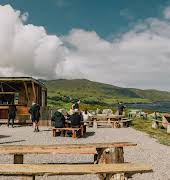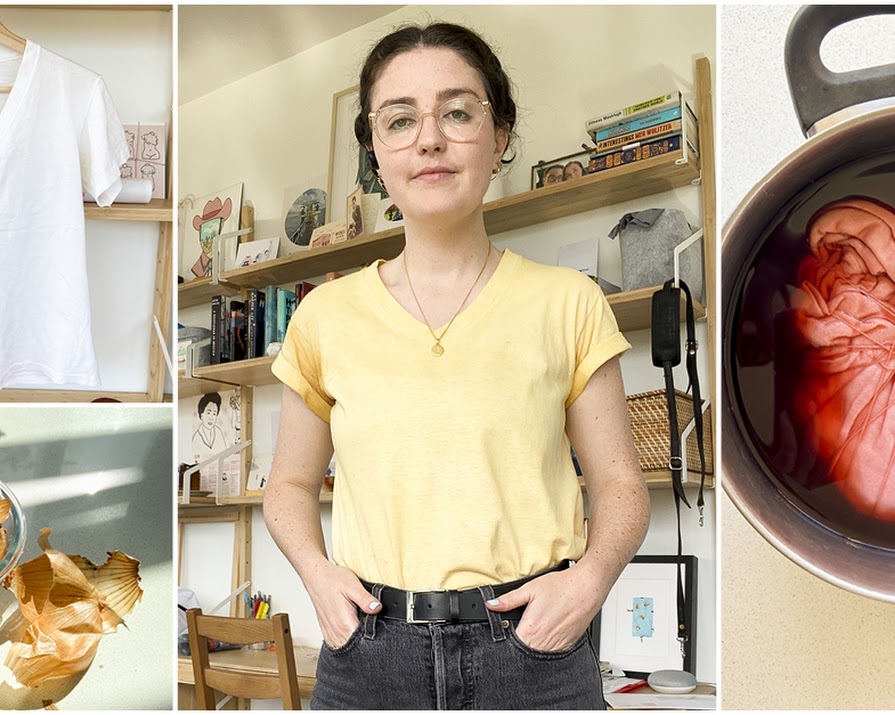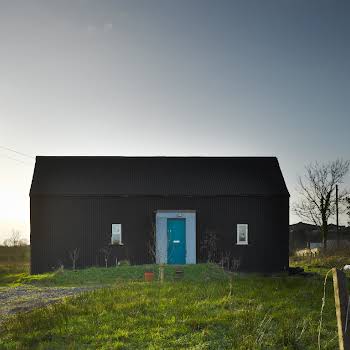I dyed a t-shirt using onions and avocados, and the results were surprisingly lovely
By Cathy Carey
20th Aug 2020
20th Aug 2020
Looking for a DIY project you can do at home with items you already have? Cathy Carey tries her hand at natural dyeing, with rather beautiful results.
If you’re looking for fun DIY projects that don’t require leaving the house to gather supplies for, then put “making natural fabric dyes” at the top of your list. Following along with Irish natural dyer Kathryn Davey‘s Instagram tutorial, I using nothing but a pot of boiling water, some onion skins and a handful of avocado pits to give a colourful new lease of life to a couple of t-shirts that were lying around my apartment last week.
It might seem daunting, but if a novice like me can do it, you can too. Here are some cool things about making dye from these foods:
- It doesn’t require any protective gear (just common safety sense)
- The ingredients are destined for the compost anyway
- The resulting colour is different every time: it depends on the fabric, how long everything is left steeping, and the quantity of ingredients you use
Natural dyers like Kathryn Davey (@kathryn_davey) and Julie D. O’Rourke (@rudyjude) have posted some very nice video tutorials on their Instagram accounts for tinting natural fabrics like cotton, wool, linen and silk at home. I followed them step by step, and I’m pretty pleased with how my t-shirts came out. Full disclosure: I’ve never tried this before, so once you’ve read my amateur attempt below, head over to their Instagram accounts and use the experts’ guides to try it yourself!
My first attempt: Making yellow dye with onion skins
Step 1: Preparation

I peeled the outside skins of three large yellow onions (the dry bits, no fleshy parts), dropped them in a pot with 2 litres of hot water, and brought it to the boil. I did very little prep with the t-shirt: I soaked it, made sure it was wet all over, and squeezed it out (more on it later).
Step 2: Dye

The colour from the onion skins seeped out quickly, and within about 10 minutes I could see the water was turning yellow. After an hour at a high simmer, the water was a pretty dark orange, so I took the pot off the heat and scooped out the onion skins.

I also made sure to sift out any tiny bits that were left in there (the tutorial advised that contact between any remaining onion skins and fabric can create deeper coloured patches). Then I submerged my t-shirt in the orange water for about an hour before removing it, squeezing it out, and running it under cold water to release excess dye.
Result

The wet t-shirt had a vibrant yellow that turned to a more buttery shade as it dried, which I actually preferred. The colour was fairly even all round, except in the armpits where the dye went darker than the rest of the t-shirt. After a quick Google search, I realised that the chemicals from deodorant can attract natural dye, and, unfortunately, these chemicals can be very hard to remove because they remain on the fabric even when it looks like they’re not there.
What I Learned
My t-shirt had been cleaned recently, but it was old. In hindsight I’d use a less-worn t-shirt to produce more even results. If you’re using an old t-shirt that has chemicals from deodorant still hiding within the the threads, the dye will likely be darker there. I’m not sure how to get around this one, so maybe give it really good hot wash with extra stain remover, or bleach, or try your best with any other methods you know to rid it of chemicals. It’s something to be aware of if you decide to take your chances with an older garment!
One other thing I’d do differently next time is put more water in the pot initially. The fabric should be fully submerged for an even colour, so I’d account for the extra water I’d adjust the amount of ingredients or fabric soaking time if I wanted a similar hue.
My second attempt: Making pink dye using avocado pits
Step 1: Preparation

Like any good millennial, I already had a few avocados in the kitchen. The instructions recommended using more stones for a stronger colour, so I bought a couple more and had myself a little avocado toast feast in preparation. Once satisfied, I got to work.
As per Kathryn’s instructions, I peeled the avocado stones well so there was no skin at all left on the outside. I also wet the t-shirt evenly all over and squeezed out the excess water. Because this top was new and never worn, there were no deodorant-y pitfalls (pun very much intended) to deal with.
Step 2: Dye

Patience was definitely a virtue with this dye extraction: it took a lot more time than the onion skins did. The instructions advise against boiling them at a high heat – low and slow is recommended. I had slightly more water than last time too, so it was a while before I saw the colour change, but it did happen eventually. In alI, I simmered the avocado stones, lid on, for about 6 hours until it was a beetroot shade and I decided the water was dark enough.

I strained the water and made sure no debris was left before adding the t-shirt in, which I had rolled up for a tie dye effect. There are lots of ways you can do this (I Googled a how-to online), but for this design I stuck a fork in the middle and twisted the fabric around it, then wrapped the t-shirt tightly in thin cotton twine. I left it in for 4-5 hours before removing: like the longer boil time, the dye was slower to take to the fabric. Finally, I removed the t-shirt from the pot, cut off the twine, and rinsed it in cold water until it ran clear.
Result

I switched the style up with a tie dye for this one, and I was glad I did, I think it looks pretty fun! The peachy pink is, appropriately, a nice millennial shade.
What I Learned
After how fast the process was with the onion skins, I expected the avocado stones to be much the same. I was wrong. I had to learn to be patient for this one, which is not a strong suit of mine, but it paid off in the end.

Next time I would probably use twice the number of avocado stones (so roughly 6-8 for two and half litres) to get a more potent dye. I realise this is quite a few, so if you’re not an eight-avocados-a-day kind of household, you can freeze the stones and save them until you have enough.
Thanks to Kathryn Davey and Jamie D. O’Rourke for their excellent tutorials, the easy-to-follow steps were a wonderful way to explore how to dye fabrics naturally for the first time. If you do decide to try it, let us know how you get on!
Read more: How to upholster a piece of furniture like a pro
Read more: This is why we’re OBSESSED with baking bread right now
Read more: 10 free resources (from dancing and music to kid’s activities and audiobooks) to try while you’re in lockdown























